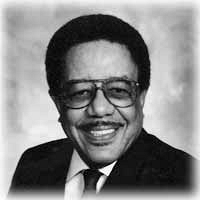Standing near where he and other young Wichitans made history 65 years ago, Galyn Vesey recalled the steadying influence of lawyer Chester I. Lewis during the Dockum Drug store sit-in. There had been threats from some white residents opposed to the lunch counter’s desegregation, and if violence broke out, the police response wasn’t hard to imagine.
“Chet reassured us more than once, ‘If you have to go to jail, I will get you out,’” Vesey said, using Lewis’ nickname.
No one went to jail, and the young black protestors eventually succeeded in desegregating the lunch counter, the first successful sit-in of its kind in the United States.
Lewis’ role in the Dockum sit-in is one of several civil rights battles highlighted in the newly remodeled Chester I. Lewis Reflection Square Park at 205 E. Douglas Ave. A ribbon cutting was held last month at the park, which sits half a block from the former site of the Dockum Drug store, now home to the Ambassador Hotel.

Former City Councilwoman Lavonta Williams, Brenda Davis, Galyn Vesey and City Councilman Brandon Johnson participated in the rededication of Chester I. Lewis Reflection Square Park.
The green space now features a house-like structure and six tall vertical structures emanating out from it, meant to symbolize the opening of its roof and walls. The vertical structures contain artwork, photographs and text detailing Lewis’ life and work, which included helping desegregate the city’s facilities, schools, work force and housing.
Speakers likened the park to an open-air museum and said they hope it teaches and inspires future generation. District 1 City Councilman Brandon Johnson acknowledged he’d learned something about Lewis himself.
“I had no idea that that brother did all you see in this park.”
Lewis’ daughter, Brenda Davis, said her father “wanted all people to be free of racism, hatred and oppression.”
She said her father would have approved of the park’s location, which serves as kind of an entranceway to the new Kansas College of Osteopathic Medicine, since he often talked about the importance of education. Lewis, who is director of nursing at Catholic Care Center in Bel Aire, also noted that each of the park’s vertical structures holds a CR code enabling people to learn more about her father and the civil rights movement here. A guided audio tour is available with a smart phone or device.
Davis said it was important to Lewis’ family that one structure contain the names of Vesey and others who participated in the Dockum sit-in.
At the time of the sit-in, Lewis was only about a decade older than the protesters but already a seasoned veteran of the civil rights movement. Lewis grew up in Hutchinson, where his father published an African American newspaper, the Blade, and his mother taught school. After serving in the U.S. Army, Lewis earned his undergraduate and law degrees from the University of Kansas and moved to Wichita.
Lewis had been practicing law here only a short time when in 1953 he sued the mayor, city manager and 11 other officials on behalf of two young black students who had been denied admission to the municipal pool then located in Riverside Park. The lawsuit led to the desegregation of the city’s pools.
In 1956, Lewis appeared before the city commission, protesting that four young black girls had been improperly detained and questioned by police after leaving the Dunbar Theatre on Cleveland. At the same meeting, Mayor A.E. Howse proposed the establishment of a “Negro committee to survey problems of Negroes,” urged the police department to enforce the law “without respect to race, color or creed” and said the city would examine its hiring procedures. Lewis was named its vice chair. The next year, he became president of the local NAACP chapter.
One of the park’s vertical displays notes that in 1963, Lewis helped organize a fair housing march that was the largest public demonstration in Wichita’s history up to that time. Lewis was a leader of a group called the “Young Turks” that tried to move the national NAACP into a more protest-oriented direction. When that failed, he quit the organization and endorsed the Black Power movement, continuing to fight for civil rights. One display in the park highlights his discrimination lawsuit that won 71 black railroad porters $6 million in 1983.
Lewis died of cancer in 1990, at age 61.
Davis said her father also would have enjoyed the ceremony’s music, which included performers singing songs by Stevie Wonder, Aretha Franklin and James Brown. “He loved black music. He loved to party.”









